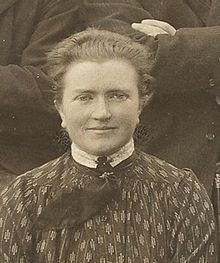Janet Lane-Claypon
Janet Lane-Claypon | |
|---|---|
 Dr. Lane-Claypon in 1907 | |
| Born | Janet Elizabeth Claypon[1] 3 February 1877[2] Boston, Lincolnshire, England |
| Died | 17 July 1967 (aged 90) Seaford, East Sussex, England |
| Spouse | |
| Medical career | |
| Profession | Doctor |
| Sub-specialties | Physician |
| Research | Epidemiology |
Janet Elizabeth Lane-Claypon, Lady Forber
Early life and education
Lane-Claypon was born Janet Elizabeth Claypon in 1877 into an affluent family, in Boston, Lincolnshire, the daughter of William Ward Lane-Claypon, a banker and former first-class cricketer, and Edith (née Stow). Her uncle C. G. Lane was also a first-class cricketer.[4] A few weeks after her birth, her father changed the family name to Lane-Claypon by royal license.[5]
She was privately educated and entered the
Career
Immediately after her education, Lane-Claypon began research at University College, London. During the first phase of her career, Dr. Lane-Claypon's research focused on female reproductive physiology—specifically the structure and function of the ovary.[8]
In 1912, Lane-Claypon published a ground-breaking study of two cohorts (groups) of babies, fed cow's milk and breast milk respectively. Lane-Claypon found that those babies fed breast milk gained more weight, and she used statistical methods to show that the difference was unlikely to occur by fluke alone. She also investigated whether something other than the type of milk could account for the difference, an effect known as confounding.[7]
Having demonstrated the power of cohort studies, Lane-Claypon went on to develop another key type of epidemiological investigation, the
In 1916, Dr. Lane-Claypon was named the dean of King's College for Women. However, departmental politics and pressures led her to resign her post and return to research, where she remained until the end of her career.[8] In total, Lane-Claypon published three books and 30 scientific papers.[6]
Personal life
In 1929, Lane-Claypon married civil servant Sir
Lady Forber died in 1967, aged 90.[2]
References
- ^ England & Wales, Civil Registration Birth Index, 1837-1915
- ^ S2CID 37020013. Retrieved 28 July 2017.
- PMID 15234929.
- ISBN 9781860645020. Retrieved 28 July 2017.
- ^ "No. 24433". The London Gazette. 13 March 1877. p. 2026.
- ^ PMID 17068415.
- ^ ISBN 9781135963439. Retrieved 28 July 2017.
- ^ doi:10.1093/ref:odnb/61714. (Subscription or UK public library membershiprequired.)
- ^ Lane-Claypon, JE (1926). "A further report on cancer of the breast : with special reference to its associated antecedent conditions". Reports on Public Health and Medical Subjects. 32.
- ^ Archives, The National. "The Discovery Service". Discovery.nationalarchives.gov.uk. Retrieved 4 May 2019.
External links
- Ellen Leopold; Warren Winkelstein Jr. (May–June 2004). "Unsung Heroines: Unveiling History: Janet Elizabeth Lane-Claypon". BCA Newsletter #81. Archived from the original on 27 September 2007.
